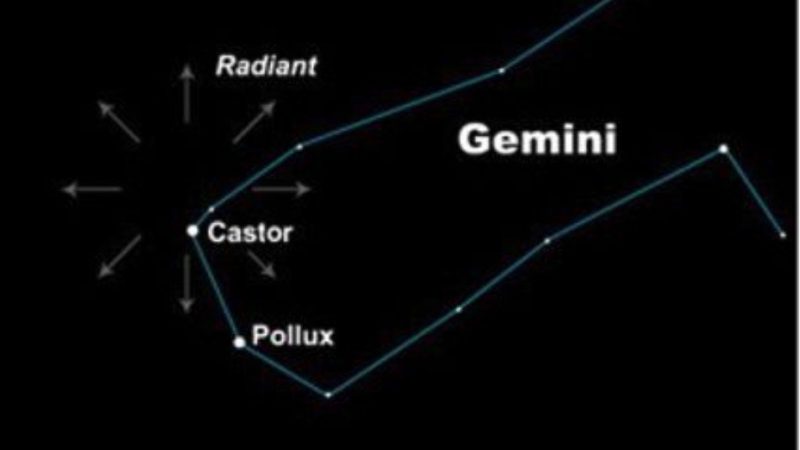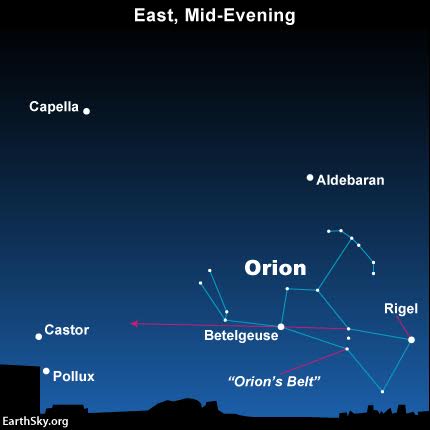
Tonight – December 11, 2017 – we might see some Geminid meteors flying about, although the forecast calls for the following night (night of December 12 and 13) to produce more meteors. On the peak night of the shower, you can often expect the see 50 or more meteors in a dark, moonless sky. At mid-northern latitudes, you can start watching for Geminid meteors around 9 p.m. The Geminids streak the nighttime sky most prolifically in the wee hours after midnight, centered around 2 a.m. local time. The Geminids tend to be bright meteors and some Gemini meteors might be able to overcome a sky somewhat beset by light pollution.
People always ask:
How can I find the radiant point of the meteor shower?
You don’t have to locate the radiant of the Gemini meteor shower to see the Geminid meteors. The Geminids streak through any number of age-old constellations, but if you trace their paths backward, these meteors appear to radiate from the star Castor in the constellation Gemini. In fact, that’s the easiest way to find a meteor shower’s radiant point. Just wait to see a meteor and trace its path backwards. After several meteors, you’ll start to get the general idea of the radiant’s location on the sky’s dome.
But maybe you want to see the radiant before you see any meteors? In that case, look for the two brightest stars in Gemini, Castor and Pollux. They’re noticeable on the sky’s dome for being bright and close together. The radiant for the Geminids is near the star Castor.
EarthSky astronomy kits are perfect for beginners. Order today from the EarthSky store

From mid-northern latitudes, Castor climbs above the eastern horizon around 8 to 9 p.m. local time. From temperate latitudes in the Southern Hemisphere, this star will rise later in the evening. But from everywhere worldwide the radiant will be highest in the sky and the meteors will fall most abundantly around 2 a.m. local time. Moving westward through the night, the stars Castor and Pollux in Gemini climb high overhead after midnight and swing into the western sky by dawn.
Of course, the Geminid meteors don’t really come from the star Castor. The radiant nearly aligns with this star by happenstance. When Earth in its orbit crosses the orbital path of the asteroid 3200 Phaethon, bits and pieces from this mysterious “rock comet” burn up in the Earth’s upper atmosphere as Geminid meteors some 100 kilometers (60 miles) above Earth’s surface.
The star Castor, on the other hand, lies way outside our solar system, at a distance of about 51 light-years.

According to Greek sky lore, Castor and Pollux were twin brothers, born from Leda, their mortal mother, and sired by Zeus, the immortal god. Though the brothers were united in spirit, they were divided by circumstance. Castor, the mortal, was slain in battle, leaving his immortal brother inconsolable with grief. Pollux asked Zeus to release him from immortality, so he could join his brother in the great beyond.
Today, the Gemini Twins stand together in the heavens, a testament to the redemptive power of brotherly love.
Bottom line: Geminid meteors appear to radiate from near the star Castor in Gemini. Best way to find this radiant is to see a meteor! Then trace its path backwards.
EarthSky lunar calendars are cool! They make great gifts. Order now. Supplies limited.











